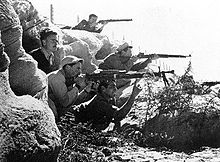Nadene Goldfoot
Moshe Dayan (1915-1981) in middle
Dayan’s first act on the Temple Mount, only a few hours after IDF Chief Rabbi Shlomo Goren blew the shofar and gave the Shehecheyanu blessing beside the Western Wall, was to immediately remove the Israeli flag that the paratroopers had raised on the mount.
Dayan’s second act was to clear out the paratroop company that was supposed to remain permanently stationed in the northern part of the mount. Dayan rejected the insistent pleas of the head of Central Command, Uzi Narkiss, who tried to prevent him from taking this measure. Narkiss reminded Dayan that Jordan, too, had stationed a military contingent on the mount to maintain order, and that long ago the Romans had done the same, deploying a garrison force in the Antonia Fortress that Herod had built near the mount. But Dayan was not persuaded. He told Narkiss that it seemed to him the place would have to be left in the hands of the Muslim guards.
Despite harsh criticism from religious and nationalist circles, Dayan, just a few hours after his first public announcement to the Israeli people about the holy places and particularly the Temple Mount, succinctly stated: “We have returned to the holiest of our places, never to be parted from them again….We did not come to conquer the sacred sites of others or to restrict their religious rights, but rather to ensure the integrity of the city and to live in it with others in fraternity.”
David Ben Gurion ( David Gruen) 1886-1975) 1st Prime Minister, Minister of Defense, organized the Israeli armyHere Dayan behaved as the successor of David Ben-Gurion, who already during the War of Independence in July 1948, when it appeared that the Jewish forces were about to conquer the Old City,
ordered David Shaltiel, Haganah commander in Jerusalem (Jewish self-defense group in Eretz Israel) or Palestine before 1948, to “prepare a special force, loyal and disciplined…
that will use without mercy a machinegun against any Jew who tries to rob or desecrate a holy place, Christian or Muslim.” Ben-Gurion also recommended that Shaltiel mine the entrances to the holy places so as to prevent harm to them.
Haganah, They succeeded the Ha-Shomer in 1920 that had formed. and Haganah kept going until 1948. Then members transferred to Tzeva Haganah Le-Israel. Under the British, there was little if any protection for the Jewish population. That's why they had formed.
And may this be the last, Israeli casualties of war, in addition to those of Israel's nine major wars, include 9,745 soldiers and security forces personnel killed in "miscellaneous engagements and terrorist attacks", which includes security forces members killed during military operations, by fighting crime, natural disasters, diseases, traffic or labor accidents and disabled veterans whose disabilities contributed to their deaths.
Between 1948 and 1997, 20,093, Israeli soldiers were killed in combat, 75,000 Israelis were wounded, and nearly 100,000 Israelis were considered disabled army veterans.
On the other hand, in 2010 Yom Hazikaron, Israel honored the memory of 22,684 Israeli soldiers and pre-Israeli Palestinian Jews killed since 1860 in the line of duty for the independence, preservation and protection of the nation, and 3,971 civilian terror victims.
The memorial roll, in addition to IDF members deceased, also include fallen members of the Shin Bet security service, the Mossad intelligence service, the Israel Police, the Border Police, the Israel Prisons Service, other Israeli security forces, the pre-state Jewish underground, and the Jewish Brigade and the Jewish Legion (which served alongside British forces in World War II and World War I respectively).
Regular conflicts
Bold indicates conflicts considered wars by the Israeli Ministry of Defense (as they were named by Israel):
Israel has had enough casualties of war for a teeny country now maintaining a population of about 9.053,070 million with about 6 of those million being Jewish and this was figured in 2023 by the worldometer. This amounts to 0.11% of the world's population. Back in 1955, the population was only 1,691,878 which was 0.06% of the world population. They have been so unimportant to the world population-wise, but important in other ways; the very seat of the Bible...a people who have come back to life after the Nazis tried to stamp them out, to eradicate them like unwanted rats, as that's how they saw Jews.
Jews know; they realize how others see them. They are determined; I know I am, to show that they are there in Israel to stay; that their rights will not be taken again from them; that they stand for justice and peace--something that was taken from them....that the moment any of this is threatened, even by their own government--they will rise up. So you've seen them in action. Don't try to stifle these creative minds with any type of hatred--whether it be from BDS or Iran.. They are there to repair the world from Jerusalem somehow, some way, and will do so.
Reference:
https://en.wikipedia.org/wiki/Israeli_casualties_of_war

.jpg%206%20day%20war.jpg)
-Aerial-Jerusalem-Temple_Mount-Temple_Mount_(south_exposure).jpg)

.jpg%20Moshe%20Dayan.jpg)




.jpg%20Haganah%201942.jpg)
No comments:
Post a Comment